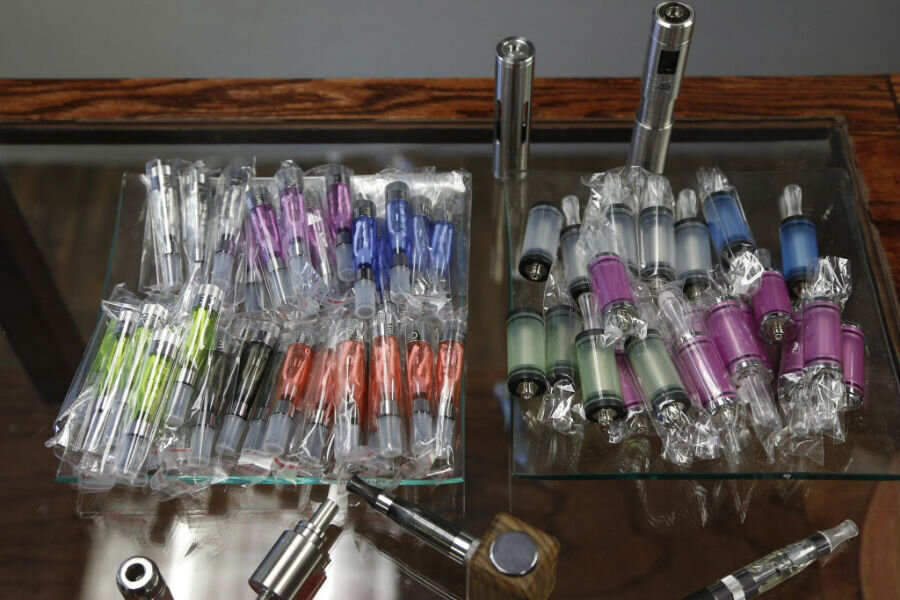California officials seek to regulate electronic cigarettes
Loading...
California health officials declared this week that electronic cigarettes are a health threat that should be regulated like tobacco products. As “vaping” gains popularity, health advocates across America have been pushing for tighter regulations.
Now, the California Department of Public Health is joining their efforts. While further research is needed to establish the immediate and long-term health effects of vaping, a recent report by the department claims that e-cigarettes are addictive and release cancer-causing chemicals.
Electronic cigarettes heat liquid nicotine into inhalable vapor, excluding the tar and many of the chemicals found in traditional cigarettes.
Experts say that if electronic cigarettes are not regulated, young people risk becoming addicted and developing health problems as a result.
"E-cigarettes are not as harmful as conventional cigarettes, but e-cigarettes are not harmless,” California Health Officer Ron Chapman told the Associated Press. "They are not safe."
The report by California’s Department of Public Health claims that 17 percent of high school seniors already use e-cigarettes, which emit about 10 toxic chemicals.
But supporters of e-cigarettes say the product helps longtime smokers kick their habit. They also point out that there is no evidence the toxic chemicals in e-cigarettes are released at dangerously high levels.
"Despite the health officer's false claims, there is ample evidence that vaping helps smokers quit and is far less hazardous than smoking," American Vaping Association president Gregory Conley said in an e-mail to AP.
The 2014 Monitoring the Future survey, which tracks substance-abuse trends among US middle and high school students, found that the use of e-cigarettes has surpassed the use of traditional cigarettes among teens. The survey says that more than twice as many eighth- and 10th-graders reported using e-cigarettes instead of tobacco cigarettes.
Critics claim that e-cigarettes’ growth in popularity among young people is due to insufficient regulation. Vaping lounges have appeared in cities throughout California, advertising for e-cigarettes is permitted where ads for tobacco products is not, and flavors popular among children, such as cotton candy, gummy bear, and watermelon, are sold regularly, even as flavored cigarettes are banned federally. Hello Kitty, a popular cartoon character, was also featured on some of the packaging.
The increase in popularity has been accompanied by an increase in accidental exposure. In 2014, there were 154 cases of e-cigarette poisoning among children under 5 in California. That is up from seven cases in 2012.
Aiming to put an end to the ubiquity of the e-cigarette, California state Sen. Mark Leno (D) proposed legislation this week to ban the use of e-cigarettes in public places. Currently, it is permissible to use e-cigarettes in hospitals, restaurants, stores, offices, and schools.
"Like traditional cigarettes, e-cigarettes deliver nicotine in a cloud of other toxic chemicals, and their use should be restricted equally under state law in order to protect public health," Senator Leno said in a statement.
But a 2013 study in the academic journal Tobacco Control found that "the levels of potentially toxic compounds in e-cigarette vapour are 9–450-fold lower than those in the smoke from conventional cigarettes.”
California banned the sale of e-cigarettes to minors in 2010, and numerous California counties and cities have prohibited vaping in specified areas. But Leno is now pushing for even stricter regulations.
Many observers, however, believe that the influence of the tobacco industry in California will make it difficult to pass such legislation.
Other states, including Oklahoma, Tennessee, and Arkansas, have issued warnings about the use of e-cigarettes. Legislatures have also been considering adding requirements to make the packaging childproof and imposing taxes to discourage their use. Federal regulators have proposed regulating the sale of e-cigarettes under the Tobacco Control Act, but regulations could take years to become finalized.
• This article includes material from the Associated Press.








